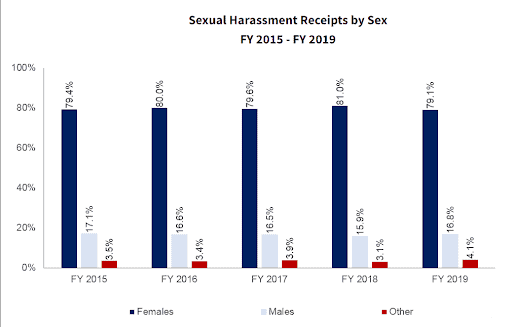


Has your coworker made you feel uncomfortable at work? Do you feel a lingering gaze? Perhaps your coworker made suggestive comments. Or maybe your coworker pressured you into giving sexual favors in exchange for a promotion or not being fired?
A sexual harassment lawyer can help stop sexual harassment in the workplace by:
Further, you should know, that sexual harassment comes in different shapes in forms. The traditional male-female harassment is not the only form of sexual harassment. A sexual harassment attorney can help you work through:
Whether you want to file a complaint in court and sue for damages or just need legal advice, we are here to help. If you have been sexually harassed at work, don’t stay silent.
Harassment is behavior that creates a severely uncomfortable workplace for an employee. There are two different types of harassment: 1) quid pro quo sexual harassment or 2) hostile work environment.
Quid pro quo sexual harassment occurs when an employee is offered a promotion, pay, benefits or the offer to keep their job in exchange for sexual favors.
For example, your supervisor or boss offers to promote you if you sleep with him.
A hostile work environment is created when an employee is subject to conduct that is:
You have to prove each of these “elements” to establish a hostile work environment claim.
Contrary to popular belief, there are different types of sexual harassment. Sexual harassment does not occur only when a man harassses a female coworker. Rather, it involves any harassment based on sex.
Women can harass women. Men can harass men. And men can harass women.
Further, there is also sexual orientation harassment. The Supreme Court, in 2020, announced that harassment based on sexual orientation is protected under the law.
Examples of different types of sexual harassment include:
Most people think of female sexual harassment when they think of sexual harassment lawsuits. It’s still true that the vast majority of sexual harassment lawsuits involve male harassers and female victims.
According to EEOC data, that number hovers around 80% of all charges filed.
When we talk about harassment, there are two different types.
First, quid pro quo sexual harassment. When an employee is offered a promotion, pay, benefits or the offer to keep their job in exchange for sexual favors.
For example, your supervisor or boss offers to promote you if you sleep with him.
Unwelcome sexual advances are common for those who have experienced sexual harassment.
In harassment cases, unlike discrimination cases, you do not need to show that any employment action was taken. So, you don’t have to wait until you’re fired to sue. These tend to be a bit harder to prove than those cases in which a tangible employment action was taken.

First, hostile work environment cases. In these cases, you have to show that the sexual harassment was unwelcome.
This normally means that the employee did not welcome the inappropriate conduct, or that it was not consensual. In other words, that any person would consider the conduct offensive.This can include flirting, inappropriate jokes or remarks, or unwanted touching.
Next, the employee must prove that the conduct was based on sex or sexual nature. This doesn’t include conduct where your supervisor targets you because they are a jerk, not because you are a woman or a man, or a member of the LGBTQ community.
Then, the employee must show that the conduct was offensive to a reasonable person and to you. In other words, not only must you find the conduct offensive, but it has to be the type of conduct that anyone would find offensive.
Lastly, you must prove that the conduct was severe or pervasive. Severe means that the behavior was extreme. This means that petty slights and trivial inconveniences are not enough.
Pervasive means that the conduct must be repetitive and occurred often. Generally, a single incident is not enough. Except, maybe, a single incident of sexual assault.
But the more severe the incident, the less pervasive it need be.
Cases that a judge already decided provide great examples of what courts consider sexual harassment.
In LaRochelle v. Wilman Corp., the court considered whether the plaintiffs’ (employees suing) claims created a hostile work environment. In this case, multiple plaintiffs-employees were suing their employer for sexual harassment.
In this case, one of the Plaintiffs-employees, Riker, presented evidence that:
The court found that this touching, hugging, and rubbing was not severe and pervasive. The shoulder rub and the hug occurred over a three-and-a-half-year period.
The court also found that “yelling” was not, without a reference to gender, evidence of a gender-based hostile work environment claim.
“Over the years she was employed at Lancashire Hall, the unwelcome hug and rubbing of Riker’s shoulders was undoubtedly crass and unwelcome, but that does not necessarily make the Defendants liable. While being “yelled at” by Bernard may be unpleasant, these types of allegations, without reference to her gender, do not support a gender-based hostile work environment claim.”
This case makes an important point that all people suing sexual harassment should understand. Courts will interpret for themselves whether the conduct is severe and pervasive.
Even though most people would consider this unwanted sexual advance as sexual harassment, you still may not win.
This is not to discourage you from seeking a sex harassment attorney to help you out. I hope it encourages you. The situation may have been different had a sexual harassment lawyer been involved sooner.
You should never become discouraged from standing up to workplace sexual harassment.
And one less than positive result with one judge does not mean that a different sexual harassment lawyer with a different judge could not have achieved a better outcome with the same facts.
A sexual harassment attorney can advise you on how to protect your rights and report the harassment. And whether it makes sense to file a charge with the Equal Employment Opportunity Commission (EEOC).
Congress created laws against sexual harassment to protect women from male harassment in the workplace. But sexual harassment laws do not only protect only females from harassment.
The law’s actual language provides that when the unwelcome conduct is “based . . . on sex,” then it fits the definition of harassment.
The EEOC put together data on who files sexual harassment claims. Still, women make up the majority of claims. But as you can see, men make up a sizeable minority of sexual harassment claims.
 EEOC Sexual Harassment Charge Data
EEOC Sexual Harassment Charge DataThe “other” category you see is made up of pregnancy, transgender, and sexual orientation harassment.
As you might guess, male sexual harassment often occurs when a female supervisor makes sexual advances on male employees.
The EEOC, on its website, provides a specific example of male sexual harassment. While working at a grocery store, a female manager made unwelcome sexual comments to a male storeworker.
She informed the employee of her desire to have affairs with male workers. She also “flashed her breasts.” He quit because of her behavior.
The first point you should note is that this behavior was unwelcome. There was a clear power disparity, which often happens in sexual harassment cases.
Further, she made it known that this unwelcome behavior was based on sex. She told him of her desire to have affairs with male workers. Most times, however, the harasser will not make his, her, or their intentions so clear.
The behavior certainly seemed pervasive and definitely offensive.
Men can often feel ashamed to come forward with these types of complaints. Although it is certainly true that women tend to face more harassment and discrimination, men do as well.
The law here aims to protect against unequal power disparities in the workplace. If your boss is harassing you because of your sex, you have a legal claim. And, sometimes, even if it is not your boss, you still might have a case.
Further, the court has also recognized same-sex harassment. This means that a person of a particular sex harassed someone else because of their sex.
This is generally harder to prove. But it’s certainly not impossible. Perhaps a male harassed and berated only male employees, but treated the women in the office much more favorably. Or perhaps the comments were clearly based on sex, such as using the term “bitch.”
Courts have also found the harassment must be because of sex, but that does not mean that there must be sexual desire present.
The Pregnancy Discrimination Act 1978 amended Title VII of the Civil Rights Act of 1964 to include pregnancy in the definition of sex.
Pregnancy discrimination makes it unlawful to harass a woman because of pregnancy, childbirth, or a medical condition related to pregnancy or childbirth. Like sexual harassment, the conduct must be severe or pervasive.
A petty slight, like you shouldn’t be exerting yourself, would likely not rise to the level of sexual harassment.
Pregnancy discrimination receives the most attention under Title VII.
Examples of the type of conduct that constitute pregnancy harassment, include:
With harassment claims, you have to measure the totality of the circumstances. This means that every case is different.
Today, sexual orientation harassment is illegal under the law. The United States Supreme Court, in 2020, found that sexual orientation is protected under Title VII of the Civil Rights Act.
The court found that the statute clearly states that discrimination “based on . . . sex” is illegal.
This case was a big win for sexual harassment attorneys and civil rights activists.
The Supreme Court clarified what sexual harassment attorneys have been advocating for decades. That you cannot discriminate based on sexual orientation in the workplace.
The court’s decision applies equally to sexual harassment lawsuits. Sexual harassment based on a person’s sexual orientation is illegal.
You can imagine the types of homophobic and transphobic remarks that those in the LGBTQ community had to endure.
If you have been the victim of sexual harassment or discrimination based on sexual orientation, the same law applies to you like others who have been discriminated against or harassed.
Coworker harassment is very common in sexual harassment lawsuits. Typically, sexual harassment is perpetrated by a supervisor.
Generally, your employer is not liable for coworker harassment, unless your employment knew about the harassment but didn’t take any action to stop it.
Your employer will defend against coworker sexual harassment by saying that it was a bad employee doing the harassing. The company had no control over him, her, or them.
You do, however, have options.
Employers are liable for coworker harassment if:
Normally, employers will have some sort of complaint procedure in place. If your coworker is harassing you, you should take advantage of the complaint procedure. If you don’t know the complaint procedure, make a complaint to human resources or your supervisor.
This puts your employer on notice. Your employer will likely take prompt corrective action. If it does not, then you have a claim for workplace sexual harassment.
Most employers have sexual harassment lawyers consulting them on these types of issues. There’s a good chance that your employer will discipline the harasser and take steps to make sure this does not happen again.
If they do not, you can file a charge with the EEOC.
Filing a charge with the EEOC will launch a federal investigation into your employer’s practices. This usually gets your employer’s attention. The EEOC will then investigate your claims.
Employees often worry that their employer will strike back against them if they file a charge. This is a legitimate worry. But you are legally protected. If an employer does do this, you will have a retaliation claim.
Retaliation is an employment claim that protects protected conduct. Complaining to the EEOC is protected conduct. If your employer acts against you because you filed this claim, you should immediately consult an employment attorney.
The #Metoo movement is a social movement where women came together to take a stand against sexual abuse and sexual harassment. Women banded together to say enough is enough inside and outside of the workplace.
More women continue to speak out. And, of course, they are now bringing more claims for sexual harassment. And employers are noticing more employees are willing to come forward about workplace sexual harassment. This is truly a good thing for all sides involved.
“Me too” evidence refers to a type of evidence supporting a sexual harassment claim. It is evidence that similar employees also suffered the same type of conduct.
If your supervisor is known for harassing other employees, this can be used to support your sexual harassment claim.
It’s helpful in sexual harassment lawsuits if employees can identify and bring witnesses to support their case. Sexual harassment lawsuits take a long time. And by the time your case is in federal court, you may have forgotten who you worked with.
That’s why it makes sense to document everything that’s happening while you’re employed. You want to note who the harasser is. Who else is being harassed. And how you are being harassed.
Chances are that if your harasser is doing it to you, they are doing it to someone else too. That’s #Metoo.
Sexual harassment makes a workplace toxic and unbearable. It is also illegal. You should not have to suffer in silence. If you’re suffering from workplace harassment, know that you have options.
More and more people have committed to standing up to this type of behavior. It should never happen. But if it does, what are you going to do?
When you decide to do something, give us a call. We are here to help.
The Lacy Employment Law Firm
Ⓒ 2022 All Rights Are Reserved